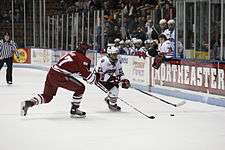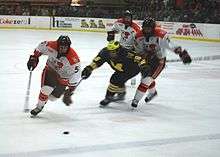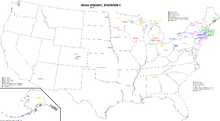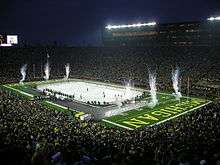College ice hockey

College ice hockey is played in Canada and the United States, though leagues outside of North America exist.
In Canada, the term "college hockey" refers to community college and small college ice hockey that currently consists of a varsity conference—the Alberta Colleges Athletic Conference (ACAC) -- and a club league—the British Columbia Intercollegiate Hockey League (BCIHL). "University hockey" is the term used for hockey primarily played at four-year institutions; that level of the sport is governed by U Sports.
In the United States, competitive "college hockey" refers to ice hockey played between colleges and universities within the governance structure established by the National Collegiate Athletic Association (NCAA) and the American Collegiate Hockey Association (ACHA).
NCAA

The National Collegiate Athletic Association has conducted national championships for men's ice hockey since 1948, and women's ice hockey since 2001.
U.S. college hockey players must be deemed eligible for NCAA competition by the NCAA Eligibility Center, a process that examines a student-athlete's academic qualifications and amateur status. Players who have participated in the Canadian Hockey League or any professional hockey league are considered ineligible.[1]
Men's U.S. college hockey is a feeder system to the National Hockey League. As of the 2010–11 season, 30 percent of NHL players (a total of 294) had U.S. college hockey experience prior to turning professional, an increase of 35 percent from the previous 10 years.[2] That percentage has been maintained the past three seasons, with a record 301 NHL players coming from college hockey in 2011–12.[3]
Men
One hundred thirty-eight colleges and universities sponsor men's ice hockey in the NCAA's three divisions.[4]
Division I
The NCAA Division I has 60 ice hockey teams as of the 2015–16 season. Twenty-one schools are Division II or III athletic programs that "play up" to Division I in hockey, and 16 schools that are full Division I members are in the Football Bowl Subdivision, six of which compete in the Big Ten Conference.
The NCAA Division I Championship is a 16-team, single-elimination tournament, divided into four, 4-team regional tournaments. The winner of each regional advances to the Frozen Four to compete for the national championship. For many years, 5 teams earned automatic bids through winning conference tournament championships, while 11 earned at-large berths through a selection committee. With the addition of the Big Ten Hockey Conference for the 2013–14 season, the tournament now features 6 automatic qualifiers, and 10 at-large bids.

In 2015–16, there were 60 schools competing in Division I, with 59 of them organized into six conferences, plus one team (Arizona State) playing as an independent program with no conference affiliation. The conferences are:
- Atlantic Hockey Association
- Big Ten Conference
- ECAC Hockey
- Hockey East Association
- National Collegiate Hockey Conference
- Western Collegiate Hockey Association
The Ivy League recognizes ice hockey champions for both sexes, but it does not sponsor the sport; it instead uses the results of regular-season ECAC Hockey matches involving two Ivy League schools to extrapolate an Ivy champion (all six Ivy League schools that sponsor varsity hockey do so for both men and women, and compete in the ECAC). The Metro Atlantic Athletic Conference sponsored D-I men's hockey, but dropped the sport in 2003.
The Hobey Baker Memorial Award honors the top player in men's Division I hockey. The Mike Richter Award honors the top goaltender in Division I.
Division II
The NCAA does not currently sponsor a championship in Division II, as there is only one conference that currently sponsors hockey, the Northeast-10 Conference. Several other schools that normally compete in Division II play up to the Division I level in hockey. The NCAA conducted a Division II national championship from 1978 to 1984 and also from 1993 to 1999.
Division III
The 74 programs in Division III hockey are part of 9 conferences:
- Commonwealth Coast Conference
- ECAC West
- Massachusetts State College Athletic Conference
- Minnesota Intercollegiate Athletic Conference
- New England Hockey Conference
- New England Small College Athletic Conference
- Northern Collegiate Hockey Association
- State University of New York Athletic Conference
- Wisconsin Intercollegiate Athletic Conference
The NCAA has conducted a Division III national championship since 1984. The current championship format is an 12-team (formerly 11-team), single-elimination bracket.
Women

Eighty-eight colleges and universities sponsor women's ice hockey in two divisions: National Collegiate and Division III.
National Collegiate
There are 36 teams in the National Collegiate division (commonly referred to as Division I). Thirty-five teams play in four conferences, with one team playing as an independent:
The National Collegiate championship is an 8-team, single-elimination tournament to determine the national champion.
The Patty Kazmaier Memorial Award is awarded annually by USA Hockey to the top player in women's Division I hockey.
The most recent school to add varsity women's hockey was Merrimack, which upgraded its women's club team to full varsity status for the 2015–16 season and joined the school's men's team in Hockey East.
Division III
There are 49 teams in Division III, plus three other programs from Divisions I and II, in seven conferences:
- Colonial Hockey Conference
- ECAC West
- Minnesota Intercollegiate Athletic Conference
- New England Hockey Conference
- New England Small College Athletic Conference
- Northern Collegiate Hockey Association
- Wisconsin Intercollegiate Athletic Conference
The Division III championship is an 8-team, single-elimination tournament to determine the national champion.
U Sports
University hockey teams in Canada compete in leagues as part of U Sports, the national governing body for Canadian university athletics (in Canadian English, the term "college" is reserved for schools that would be called "junior", "community", or "technical" colleges in the U.S.). U Sports sponsors both men's and women's hockey.
Like in the United States, teams compete in athletic conferences based on geographical locations of the schools. Unlike the NCAA, U Sports does not award players with athletic scholarships, resulting in a lack of divisional separation such as found between NCAA divisions. Individual conferences hold postseason tournaments, followed by the round-robin U Sports championship tournament in late March.[5]
NAIA
In 2015, a group of member schools in the National Association of Intercollegiate Athletics (NAIA) began working to add the sport to the organization.[6] The NAIA originally sponsored a men's ice hockey championship from 1968 to 1984 when it was discontinued due to many of the schools with teams leaving the NAIA for the NCAA. A few NAIA schools continued to sponsor the sport as varsity-club teams in the ACHA. A growing number of schools have added ice hockey as members of the ACHA over the past 5–10 years.[7]
ACHA
The American Collegiate Hockey Association (ACHA) is the sanctioning body for non-NCAA, club ice hockey in the United States. The organization provides structure, regulations and promotes the quality of collegiate ice hockey.
Teams separated into three men's and two women's divisions with over 300 teams from across the United States. The recruiting process, rules and regulations, and player eligibility standards parallel that of NCAA division 3. Sometimes, ACHA and NCAA will play games against each other to complete each of their season schedules.[8][9]
NJCAA
The National Junior College Athletic Association (NJCAA) sponsors men's ice hockey at the NJCAA Division I level. Five schools play hockey as members of the NJCAA, many also playing games against members of the ACHA and NCAA Division III JV teams. NJCAA ice hockey schools are: Dakota College at Bottineau, Erie Community College, Hudson Valley Community College, Mohawk Valley Community College, and SUNY Broome Community College. With the recent drop in sponsorship, the NJCAA will discontinue men's hockey following the 2016-17 season.[10]
NCHA
The National Collegiate Hockey Association (NCHA) was originally established in 2011 as an alternate league from the ACHA.[11] The organization is made up of 22 college ice hockey teams located in the Northeastern United States, most of which being ACHA Division III teams. Beginning with the 2014-15 season, the league is now sanctioned by the United Hockey Union.
Outdoor games in the 21st century

Men's
- Cold War – October 6, 2001 Michigan vs. Michigan State (Spartan Stadium)
- Frozen Tundra Hockey Classic February 11, 2006, Ohio State vs. Wisconsin (Lambeau Field)
- Frozen Fenway 2010 Boston University vs. Boston College and Northeastern University vs. New Hampshire(Fenway Park)
- Frozen Fenway 2012 Northeastern University vs. Boston College and Maine vs. New Hampshire (Fenway Park)[12]
- Frozen Fenway 2012 Union College vs. Harvard University (Fenway Park)
- Culver's Camp Randall Hockey Classic February 6, 2010 Michigan vs. Wisconsin (Camp Randall Stadium)
- The Big Chill at the Big House – December 11, 2010 held at Michigan Stadium set the hockey attendance record when 104,173 fans watched Michigan defeat Michigan State, 5–0.[13]
- Frozen Diamond Classic – January 15, 2012 Michigan defeated Ohio State University, 4–1, at Progressive Field in Cleveland, OH.[14]
- Frozen Frontier, December 14, 2013. Rochester Institute of Technology and Niagara University
- North Dakota and Omaha played in an outdoor game at TD Ameritrade Park in Omaha, Nebraska on February 9. 2013, with North Dakota winning, 5–2.
- Hockey City Classic February 17, 2013 Notre Dame vs. Miami University and Minnesota vs Wisconsin (Soldier Field)[15]
- Hockey City Classic January 17, 2014, Minnesota vs. Ohio State (TCF Bank Stadium)[16]
- The Battle on Blake - February 20, 2016, will be played at Coors Field between the University of Denver Pioneers and the Colorado College Tigers as part of the Battle for the Gold Pan.[17]
Women's
- January 8, 2010 Northeastern vs New Hampshire Fenway Park
- Culver's Camp Randall Hockey Classic February 6, 2010 Bemidji State vs Wisconsin Camp Randall Stadium
- Hockey City Classic January 17, 2014, Minnesota vs Minnesota State (TCF Bank Stadium)[16]
Longest-running annual international rivalry
A rivalry between the United States Military Academy (Army) Black Knights and the Royal Military College of Canada (RMC) Paladins resulted in an annual West Point Weekend hockey game.[18] The series was first played in 1923, and was claimed to be the longest-running annual international sporting event in the world.[19] Army and RMC played continuously from 1949 until 2007, when scheduling conflicts forced the academies to abandon the scheduled game.[20] The series will resume in 2011–12 and continue for the next two seasons at least.[21]
Leagues outside Northern America
In Europe the first college hockey league called EUHL was founded in 2013.[22]
In the United Kingdom, college hockey league is operated by BUIHA (British Universities Ice Hockey Association). It was founded in 2003 and currently includes 23 clubs across the UK.
See also
- Battle for the Gold Pan Colorado based college hockey rivalry
- Beanpot (ice hockey) Boston-area college hockey tournament
- College athletics
- Great Lakes Invitational
- List of defunct college hockey teams
- List of ice hockey leagues#College
- List of NCAA Division I ice hockey programs
- NCAA Men's Ice Hockey Championship
- National Collegiate Women's Ice Hockey Championship
References
- ↑ "NCAA College Hockey vs. CHL Major Junior". College Hockey inc. NCAA. January 9, 2015.
- ↑ http://collegehockeyinc.com/view/ncaa/news/news_25488
- ↑ http://collegehockeyinc.com/in-the-nhl
- ↑ NCAA Winter Sports Archived January 10, 2007, at the Wayback Machine.
- ↑ "Archived copy". Archived from the original on March 3, 2009. Retrieved March 11, 2009.
- ↑ "National Association of Intercollegiate Athletics Ice Hockey". NAIA. August 2015. Retrieved 2015-12-10.
- ↑ "ICE HOCKEY – POTENTIAL FOR RETURN TO NAIA" (PDF). NAIA-ADA. September 2015. Retrieved 2015-12-10.
- ↑ http://www.nhl.com/ice/news.htm?id=394182
- ↑ http://thehockeywriters.com/rise-acha-division-hockey/>.
- ↑ http://www.njcaa.org/sports/mice/index
- ↑ "New Room Press Release". NAIH. August 16, 2011. Retrieved August 16, 2011.
- ↑ https://bangordailynews.com/2013/04/25/sports/maine-hockey-team-to-play-its-second-frozen-fenway-game-in-january-2014/
- ↑ "Record crowd watches hockey game". ESPN.com. Associated Press. December 12, 2010. Retrieved December 13, 2010.
- ↑ "Archived copy". Archived from the original on March 13, 2012. Retrieved February 14, 2012.
- ↑ "Archived copy". Archived from the original on January 27, 2014. Retrieved February 9, 2014.
- 1 2 http://www.startribune.com/sports/gophers/222213451.html
- ↑ Nick Groke, "Denver, Colorado College prep for Coors Field hockey with first look," Denver Post, February 19, 2016.
- ↑ "Army-RMC Rivalry". Go Army Sports.com. Archived from the original on May 3, 2011. Retrieved January 1, 2009.
- ↑ Crowly, R, and Guinzburg, T: "West Point: Two Centuries of Honor and Tradition" (ISBN 0-446-53018-2), page 234. Warner Books, 2002.
- ↑ http://www.collegehockeynews.com/news/2006/02/08_top10.php
- ↑ http://www.goarmysports.com/ViewArticle.dbml?SPSID=48075&SPID=4588&DB_LANG=C&ATCLID=205156136&DB_OEM_ID=11100%5B%5D
- ↑ http://www.hlavnespravy.sk/hokej-startuje-univerzitna-liga-ma-ambiciu-rozsirit-sa-po-celej-europe/166422/
External links
- ACHA Hockey
- The College Hockey Directory
- College Hockey, Inc.
- College Hockey News
- Hobey Baker Memorial Award
- Inside College Hockey
- NCAA Men's Ice Hockey
- NCAA Women's Ice Hockey
- U.S. College Hockey Online
- NAIA ice hockey

